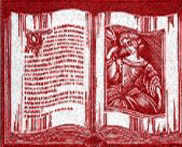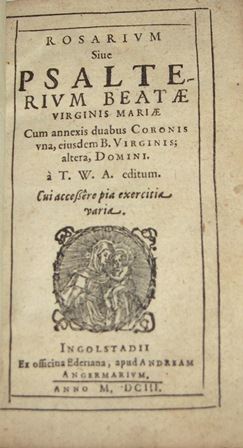

WORTHINGTON ROSARIE OF OUR LADY RARE LATIN EDITION PRINTED 1603 INGOLSTAD.
Rosarium Siue Psalterium Beatae Virginis Mariae Cum annexis duabus Coronis una, eiusdem B Virginis; altera, Domini. a T W A editum. Cui accessere pia exercitia varia.
Ingolstad, Ex officina Ederiana, Andream Angermarium, 1603.
Duodecimo,, pagination: [32], 255 [with Anwerp aprobation on final leaf dated 1600], [Size: 3.5 x 5.75 inches], text within woodcut rule with woodcut vignette on title page, 38 woodcut plates in text, most full-page, within decorative borders, bound in contemporary polished calf, with gilt stamps of Crucifixion and Virgin in centre of boards, corner fleurons, edges gilt lettered 'Rosarium' on upper board, worn at corners and edges, lacking ties, a few small wormholes to lower board, rebacked and re-labelled in somewhat inelegant style [perhaps by members of a modern religious order], with light soiling and wear only, and minor marginal faults, a good sound copy internally.
FIRST EDITION THUS of the woodcut as opposed to version of Thomas Worthington's notable work commonly called 'Our Ladies Psalter', a collection of devotional quotations and poems by the English Catholic president of Douai College, one of the greatest of the English Catholic priests of the Elizabethan period. His 'Psalter' first appeared in both English and Latin versions published in Antwerp in 1600.
The English edition, entitled 'The Rosarie of Our Ladie, with other Godlie Exercises' is, unsurprisingly, very rare, but the Latin version is much commoner than this present second printing.
The 1600 version did however have the same 37 plates [one of which is duplicated in our woodcut version to make 38] but all finely engraved by Collaert after Martin de Vos.
For this present very rare Ingoldstadt edition the same small format was retained, but the illustrations were re-engraved on wood, and with a new dedication added by the printer Andre Angermar to George Rinderbach dated 1603, the year of printing.
Woodcut illustration of this period having never received the same attention as Dutch engraving, this edition has been largely neglected by bibliographers, although there are copies recorded in European libraries, none in English libraries, and one at the University of Texas.
The fact that this copy retains a large part of its original binding, though badly restored, is most unusual for this type of pocket devotional item- most have been 'improved' with heavy 19th Century morocco bindings.
SOLD!
Rosarium Siue Psalterium Beatae Virginis Mariae Cum annexis duabus Coronis una, eiusdem B Virginis; altera, Domini. a T W A editum. Cui accessere pia exercitia varia.
Ingolstad, Ex officina Ederiana, Andream Angermarium, 1603.
Duodecimo,, pagination: [32], 255 [with Anwerp aprobation on final leaf dated 1600], [Size: 3.5 x 5.75 inches], text within woodcut rule with woodcut vignette on title page, 38 woodcut plates in text, most full-page, within decorative borders, bound in contemporary polished calf, with gilt stamps of Crucifixion and Virgin in centre of boards, corner fleurons, edges gilt lettered 'Rosarium' on upper board, worn at corners and edges, lacking ties, a few small wormholes to lower board, rebacked and re-labelled in somewhat inelegant style [perhaps by members of a modern religious order], with light soiling and wear only, and minor marginal faults, a good sound copy internally.
FIRST EDITION THUS of the woodcut as opposed to version of Thomas Worthington's notable work commonly called 'Our Ladies Psalter', a collection of devotional quotations and poems by the English Catholic president of Douai College, one of the greatest of the English Catholic priests of the Elizabethan period. His 'Psalter' first appeared in both English and Latin versions published in Antwerp in 1600.
The English edition, entitled 'The Rosarie of Our Ladie, with other Godlie Exercises' is, unsurprisingly, very rare, but the Latin version is much commoner than this present second printing.
The 1600 version did however have the same 37 plates [one of which is duplicated in our woodcut version to make 38] but all finely engraved by Collaert after Martin de Vos.
For this present very rare Ingoldstadt edition the same small format was retained, but the illustrations were re-engraved on wood, and with a new dedication added by the printer Andre Angermar to George Rinderbach dated 1603, the year of printing.
Woodcut illustration of this period having never received the same attention as Dutch engraving, this edition has been largely neglected by bibliographers, although there are copies recorded in European libraries, none in English libraries, and one at the University of Texas.
The fact that this copy retains a large part of its original binding, though badly restored, is most unusual for this type of pocket devotional item- most have been 'improved' with heavy 19th Century morocco bindings.
SOLD!



J & S Wilbraham Antiquarian Books
























